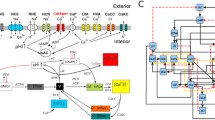Summary
About half of the inhibitory effect on the beat frequency of sea urchin spermatozoa flagella by β, γ-imido-adenosine-5′-triphosphate (AMPPNP) previously reported by Okuno & Brokaw (1981) was actually the result of inhibition by lithium resulting from the use of a tetralithium salt of AMPPNP. Li+ (or LiATP3−) acts as a competitive inhibitor of beat frequency, with aK i for Li+ of about 30 mM. Under improved reactivation conditions which reduce theK m for beat frequency to about 0.1 mM, theK i for lithium-free MgAMPPNP2− is about 2.3 mM, and magnesium pyrophosphate (MgPP −i ), which may be an equivalent ligand, gives aK i of 3.4 mM.
Similar content being viewed by others

References
BROKAW, C. J. (1975) Effects of viscosity and ATP concentration on the movement of reactivated sea-urchin sperm flagella.J. expl. Biol. 62 701–19.
BROKAW, C. J. (1977) CO2-inhibition of the amplitude of bending of Triton-demembranated sea urchin sperm flagella.J. expl. Biol. 71 229–40.
BROKAW, C. J. (1979) Calcium-induced asymmetrical beating of Triton demembranated sea urchin sperm flagella.J. Cell Biol. 82 401–11.
BROKAW, C. J. (1985) Cyclic AMP-dependent activation of sea urchin and tunicate sperm motility. In Hormone Action and Testicular Function.Ann. N.Y. Acad. Sci. 438 132–41.
GIBBONS, B. H. & GIBBONS, I. R. (1974) Properties of flagellar ‘rigor waves’ formed by abrupt removal of adenosine triphosphate from actively swimming sea urchin sperm.J. Cell Biol. 63 970–85.
GIBBONS, I. R., EVANS, J. A. & GIBBONS, B. H. (1982) Acetate anions stabilize the latency of dynein 1 ATPase and increase and velocity of tubule sliding in reactivated sperm flagella.Cell. Mot. Suppl.1, 181–4.
GIBBONS, B. H. & GIBBONS, I. R. (1984) Lithium reversibly inhibits microtubule-based motility in sperm flagella.Nature 309 560–2.
JOHNSON, K. A. (1983) The pathway of ATP hydrolysis by dynein.J. Biol. Chem. 258 13 825–32.
OKUNO, M. & BROKAW, C. J. (1979) Inhibition of movement of Triton-demembranated sea-urchin sperm flagella by Mg2+, ATP4− and Pi.J. Cell. Sci. 38 105–23.
OKUNO, M. & BROKAW, C. J. (1981) Effects of AMPPNP and vanadate on the mechanochemical crossbridge cycle in flagella.J. Musc. Res. Cell Motility 2 373–99.
PATE, E. & COOKE, R. (1985) Inhibition of muscle contraction by adenosine 5′ (β,γ-imido) triphosphate and by pyrophosphate.Biophys. J. (In press).
PENNINGROTH, S. M. & WITMAN, G. B. (1978) Effects of adenylylimidodiphosphate, a nonhydrolyzable adenosine triphosphate analog, on reactivated and rigor wave sea urchin sperm.J. Cell Biol. 79 827–32.
PORTER, M. E. & JOHNSON, K. A. (1983) Transient state kinetic analysis of the ATP-induced dissociation of the dynein-microtubule complex.J. Biol. Chem. 258 6582–7.
SILLEN, L. G. & MARTELL, A. E. (1964)Stability Constants of Metal-Ion Complexes. London: The Chemical Society.
TAKAHASHI, M. & TONOMURA, Y. (1978) Binding of 30s dynein with the B-tubule of the outer doublet of axonemes fromTetrahymena pyriformis and adenosine triphosphate-induced dissociation of the complex.J. Biochem. 84 1339–55.
TAKAHASHI, M. & TONOMURA, Y. (1979) Kinetic properties of dynein ATPase fromTetrahymena pyriformis.J. Biochem. 86 413–23.
YOUNT, R. G., BABCOCK, D., BALLANTYNE, W. & OJALA, D. (1971) Adenylyl imidodiphosphate, an adenosine triphosphate analog containing a P-N-P linkage.Biochemistry 10 2484–9.
Author information
Authors and Affiliations
Rights and permissions
About this article
Cite this article
Pate, E.F., Brokaw, C.J. Resolution of the competitive inhibitory effects of lithium and AMPPNP on the beat frequency of ATP-reactivated, demembranated, sea urchin sperm flagella. J Muscle Res Cell Motil 6, 507–512 (1985). https://doi.org/10.1007/BF00712586
Received:
Revised:
Issue Date:
DOI: https://doi.org/10.1007/BF00712586



